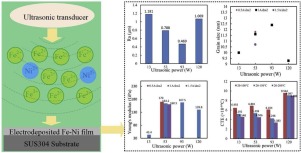当前位置:
X-MOL 学术
›
Mater. Res. Bull.
›
论文详情
Our official English website, www.x-mol.net, welcomes your
feedback! (Note: you will need to create a separate account there.)
Ultrasound-assisted electrodeposition of Fe-Ni film for OLED mask
Materials Research Bulletin ( IF 5.3 ) Pub Date : 2020-07-01 , DOI: 10.1016/j.materresbull.2020.110845 Anxin Li , Zengwei Zhu , Yapeng Liu , Junchen Hu
Materials Research Bulletin ( IF 5.3 ) Pub Date : 2020-07-01 , DOI: 10.1016/j.materresbull.2020.110845 Anxin Li , Zengwei Zhu , Yapeng Liu , Junchen Hu

|
Abstract Fe-Ni alloy is considered as the most suitable metal for OLED mask making due to its excellent properties. However, electrodeposited Fe-Ni film is often companied with poor surface quality and thermal expansion. To get proper film for masks making, experiments of electroforming Fe–Ni were performed with different ultrasonic powers and current densities. Results show that Fe-Ni film with smooth surface could be electrodeposited at high current density due to the reducing of internal stress of film by ultrasonic power. The iron content, grain size, micro-hardness and Young’s modulus of film all present an upward trend with ultrasonic power increases from 13 W to 93 W, and then a downward trend due to the intensively transient cavitation caused by higher ultrasonic power 120 W. With the ultrasonic power of 93 W and current density of 1 A/dm2, a good surface quality of Fe-Ni films with 60.07 wt.% iron content, microhardness 351 HV, Young's modulus 167.5 GPa and CTE 3.38 × 10−6/℃ can be electrodeposited.
中文翻译:

用于OLED掩模的Fe-Ni薄膜的超声辅助电沉积
摘要 Fe-Ni合金因其优异的性能而被认为是最适合制作OLED掩膜的金属。然而,电沉积的 Fe-Ni 薄膜往往伴随着较差的表面质量和热膨胀。为了获得合适的掩模制作薄膜,在不同的超声波功率和电流密度下进行了电铸 Fe-Ni 实验。结果表明,由于超声功率降低了薄膜的内应力,可以在高电流密度下电沉积表面光滑的Fe-Ni薄膜。膜的铁含量、晶粒尺寸、显微硬度和杨氏模量均随着超声功率从 13 W 增加到 93 W 呈上升趋势,然后由于较高的超声功率 120 W 引起的强烈瞬态空化而呈下降趋势。超声波功率为 93 W,电流密度为 1 A/dm2,
更新日期:2020-07-01
中文翻译:

用于OLED掩模的Fe-Ni薄膜的超声辅助电沉积
摘要 Fe-Ni合金因其优异的性能而被认为是最适合制作OLED掩膜的金属。然而,电沉积的 Fe-Ni 薄膜往往伴随着较差的表面质量和热膨胀。为了获得合适的掩模制作薄膜,在不同的超声波功率和电流密度下进行了电铸 Fe-Ni 实验。结果表明,由于超声功率降低了薄膜的内应力,可以在高电流密度下电沉积表面光滑的Fe-Ni薄膜。膜的铁含量、晶粒尺寸、显微硬度和杨氏模量均随着超声功率从 13 W 增加到 93 W 呈上升趋势,然后由于较高的超声功率 120 W 引起的强烈瞬态空化而呈下降趋势。超声波功率为 93 W,电流密度为 1 A/dm2,











































 京公网安备 11010802027423号
京公网安备 11010802027423号